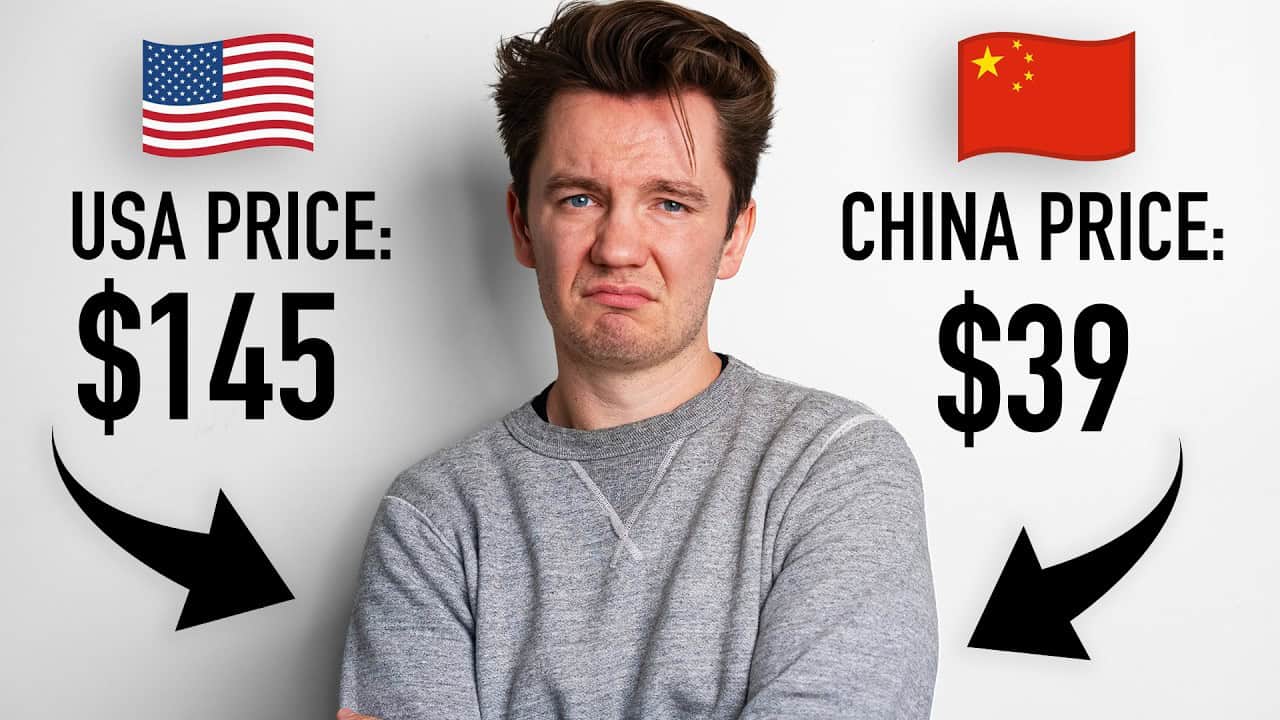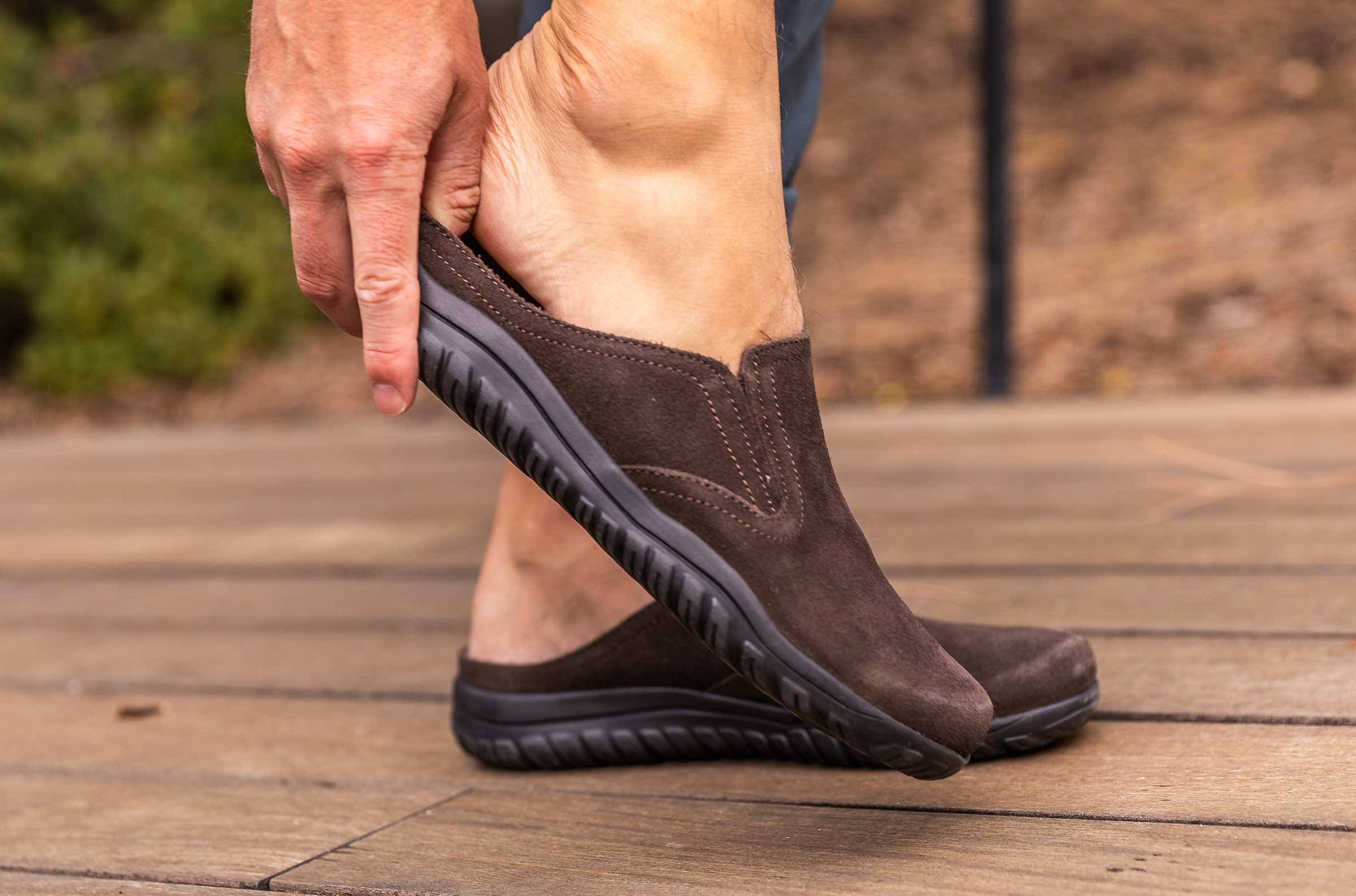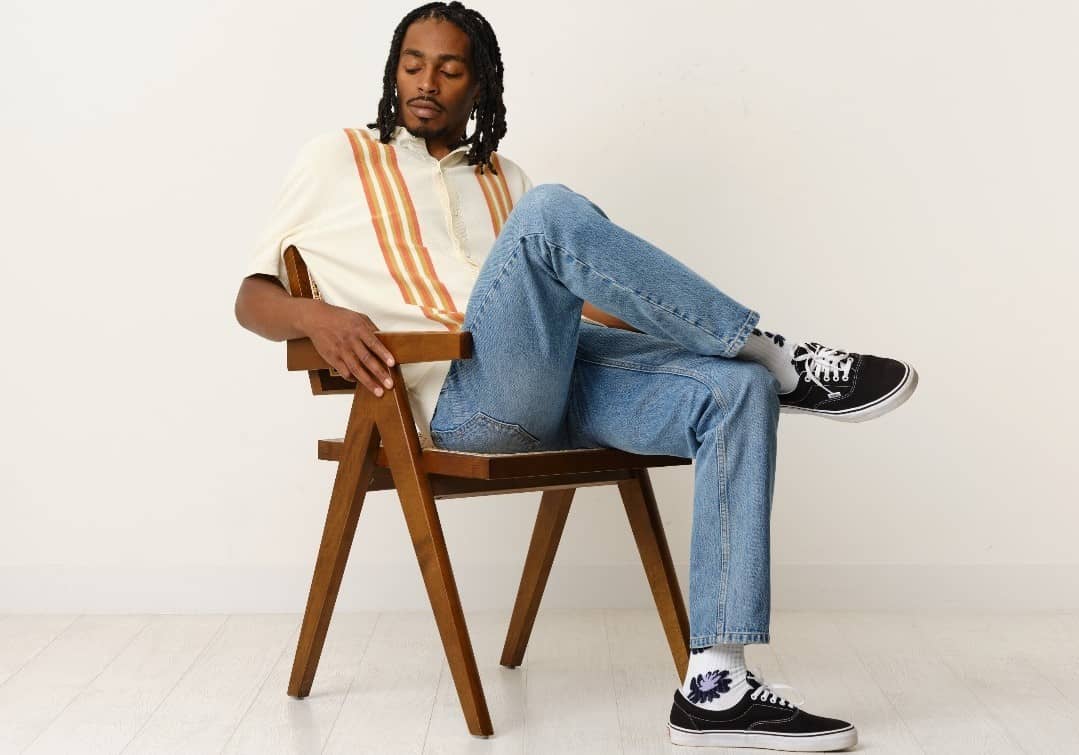The Evolution of Sex Part 3: On the Genetic Superiority of Women
Dec 24, 2025What Bronson MFG Teaches Us About Factory Direct and Brand Clothing
- Aug 13, 2025
- 0 Comments
791

We independently evaluate all recommended products and services. Any products or services put forward appear in no particular order. if you click on links we provide, we may receive compensation.
1936 Salvage Denim Reproduction Jeans
This is a pair of salvage denim reproduction jeans from 1936. They are really good quality, but you have to ignore the broken button here. Levis sells their reproduction pair for $300, but Buck Mason sells their reproduction pair for $270. So, Buck Mason is the deal, right?
No. The jeans that I’m wearing are from Bronson, a domestic Chinese vintage US military reproduction brand — one of the weirdest sentences I’ve probably ever said. They cost $90. You could get three of these for the pair of one Buck Mason same pant. Well, not same pant obviously — it’s the whole point of this video.
Not Clickbait — The Real Story
The title of this video is not clickbait. Obviously, there is probably a little bit more nuance than whatever I’ve titled it, but it’s not clickbait. It’s something that is very interesting, a bit of a phenomenon, and it all has to do with the way you shop for clothing in the US versus the way you shop for clothing in China.
Also, real quick disclaimer — I live in the US, so it might be how you shop too if you live somewhere in Europe or anywhere else in the world. I just don’t know. I’ve shopped in one Denmark mall in my entire life — it was awesome. But the way you shop for clothing and stuff like that in China oftentimes does lead to you’re paying less, you’re getting a higher quality.
How Chinese Shopping Habits Are Spreading Globally
And that way of shopping is actually leaking into the US, and it might take over US shopping with the rise of companies that you’ve probably heard a lot about: Shein, Temu, and interestingly enough, the TikTok shop. So the question is — what on earth is exactly happening?
To figure that out, I did a lot of research myself, obviously. But I also got in contact with the CEO of Bronson, Eason, and I asked him a lot of… I basically pestered their customer service until Eason was like, “Dude, what do you want to know?” And boy oh boy, did I get some answers.
How Bronson Does It
Next Up: How China Does it
So that’s that. Welcome to another Iron Snail production. Holly Crescendo the music and title card.
Like I said, I pestered the CEO, Eason, until he gave me some answers. I think there was a pretty significant language barrier, so I couldn’t get a lot of questions answered just because — well, there are a lot of weird questions anyway, like “Why… how does China work?” But I did get the biggest questions that I wanted answered… answered.
So, let’s break down why Bronson is actually so cheap. What is going on here? The easiest thing to say right away when you’re talking about very cheap clothing is, “Oh, they probably have terrible labor practices.” That’s not always the case. Could be — but it’s not always.
There’s some things that Bronson does right away that get you to a pretty low cost. You see it a lot of times with brands that make more basic clothing, and they make a lot of them, and they are direct to consumer. They’re from the factory, and that’s exactly what Bronson is doing to actually a very high degree.
Pricing Strategy and Quality
I don’t have pictures of the entire process, but they’re knitting in-house — at least t-shirts. I’m assuming also sweaters, and they said they’re weaving as well, so this denim may be their denim. Super easy-peasy way to get the price down quickly because you are not marking up things all along the process. That’s one thing.
Second thing is, Eason said they just don’t charge a lot. That’s definitely a strategy. But then there is also the glaringly obvious thing, which is — Bronson from its start is very good quality, but a lot of brands that are priced even lower are also very good quality. They just don’t take design risks like Bronson does.
I guess it’s not technically a risk because it’s vintage US military gear that they are reproducing in their own way, but the risk is that it’s not an everyday style. These are high-waisted 1936 recreation jeans. The OG 107 pants — those go up, like, to my boobs. Huge niche style. Your dad is probably not going to want to wear OG 107 pants, especially if he fought in Vietnam, because those probably bring back terrible memories.
But he’s not going to want to wear those because it’s very daring. Gap, Old Navy, other brands that you know — they could probably make a similar pant for a similar price. They just wouldn’t, because it’s not going to sell like a just regular cut-off, boring pair of chinos.
Comparing Bronson to Other Brands
And since the style of clothing they’re making, the materials and stuff that they’re using, are not comparable to real fast fashion brands, you compare it to brands that are doing something similar — which oftentimes are top-tier Japanese US military reproduction brands — and those are very different products.
Overall review of the sweater though — $80, good deal. It’s a scratchier wool yarn that’s being used, and there’s 20% acrylic, and there’s a lot of… I think anti-pilling finish on it. So, I think the acrylic will cause the sweater overall to pill over time, but it does feel nice.
Taylor said, “I looked handsome when I wore it.” It is an $80 sweater, though, and I think unlike a lot of Bronson products, you will notice over time why this is $80 when you see how it ages and wears and breaks down.
Okay, so that partially explains why Bronson is so cheap. The other thing is the thing I keep yammering on about — people don’t shop the same way in China as they do in the US. That is a big proponent as to why Bronson has to be so cheap.
I decided that I’m going to fake this.
Beaver Bites and the Bronson Outfit
Look at this. Beaver bites everywhere. There’s some right here — this is a pretty huge tree for the beavers. Got a lot of work. Well, I guess these are kind of old. Beaver bites as far as the eye can see over there. All these pointed trees. Look at that. I shouldn’t stand right under this.
According to Bronson, this is a Lot 601 1969 model 3rd salvage denim jacket. And these are my pants I’m wearing today — 1936 model cowboy salvage denim jean. $90.
China’s Super Power
Next up: USA’s Super Power
This is certainly news to no one, but China is absolutely a manufacturing powerhouse. Factories aren’t just competing with other factories saying, “We can make this cheaper for that brand.” Factories are competing with the brands, because people in China can just go directly to the factory and say, “Can you make that shirt? Instead of for $20, make it for 10.” Factories are like, “Yeah, sure.”
In the US, if you’re going to try and get something from a factory, you probably need to order an absolute ton of it to get wholesale prices, or there are a lot of hoops to go around. In China, it’s such a big thing, tech companies came up with the idea of, “Wait a minute, we can just kind of make online malls and get rid of that problem altogether.” There’s Tao, T-mall, JD, Pin Duo Duo, and Douyin (which is TikTok in China). In the US, we don’t do that.
The Brand Mentality in the US
All of our stuff is made in factories obviously, but we put it in little cubbies — and those cubbies we call brands. And if you get something made and it doesn’t have the Carhartt logo on it, even if it uses the same materials or if it’s made in the same factory, we say that is fake. That is not real. There’s probably something wrong with it.
When, on the other hand, if you’re in a manufacturing powerhouse country, gear… like, they’re literally making… I can literally see the Carhartts coming out of the door. Carhartts are bad — I don’t know if they make stuff in China, but you know what I mean. And instead of saying, “Well, I trust that Michael the Iron Snail is going to give me a really good deal and make a really good product and stand by his product and give me a good warranty and everything like that… by the way, we are working on a t-shirt — code name the Cardinal,” you don’t necessarily say that.
The Marketplace Model in China
You say, “Well, I typed in t-shirt. I saw 10,000 people in the last month bought this t-shirt and everybody gave it five stars. So, I know it’s probably good.” And that t-shirt is competing with so many other people, they should have a good standard of quality, so you end up paying less for higher quality garments. That’s what’s going on in China.
Probably thinking, “Wow, are we getting ripped off?” In theory, yes. But also, in theory, absolutely not, because there are major pros and cons of either one.
The Pros of Going Through a Brand
In theory, there are some really good benefits of going through a brand to get your product, because they should be able to support you more. Patagonia — really good example. Basically, you can bring anything into their shop and they’ll repair it for you or replace it for you. That’s a good example where you’re like, “Oh, yeah. I like Patagonia.” Even though it costs a little bit more, I’m willing to pay for it.
There’s a few other bonuses that should theoretically come with the brand, too. An important one for me is that brand story and heritage and everything like that should help keep old craft stuff alive. I’m wearing Russell Moccasin… oh, this is the Iron Snail Russell Moccasin collaboration. Old world craftsmanship. Russell Moccasin — dead in the water if they didn’t have that craftsmanship and that story and you’re like, “Oh, that’s cool. I like that.” So, that’s a big one for me.
Heritage and Craftsmanship
Same with salvage denim. If it wasn’t for Japan taking in salvage denim and saying like, “This is an art form and we’re going to make these recreation pieces and stuff like that,” it probably would be so obscure there wouldn’t be the community there is today around it.
Oftentimes, there is much more aggressive innovation — forward innovation, not just trying to make something cheaper or be constructed cheaper. Nike is never going to let Adidas eat their running marathon lunch. And that is why you go from — which I love, this Instagram picture — these early Nike running shoes or Adidas or something like that, to the modern ones. Which, by the way, if you’re a marathon runner, I could see why you’re breaking world records, because people used to just run on leather boards. Now you’re running on like carved yoga blocks.
Accountability and Ethics
It’s also way easier to hold the brand accountable. If a brand is working with really unethical labor practices — Nike got in trouble in the ’90s and 2000s. I think everybody knows it to this day. It was when I was a kid, everybody was talking about it with sneakers on the playground. But if it’s just a random factory that you got on Tao or something like that, it’s… you’ve forgotten. There’s 800 other factories. Nobody knows exactly what’s going on. Too many to track. And frankly, it’s not going to get headlines, so it’s not going to go crazy. Oh yeah, way better now.
The Brand Experience
And then you do get a bunch of nice, but not necessarily necessary things — but you get to kind of pick what brand represents me, which one is me, which is this. You get a lot more colorful brand experience. Best example, RRL. If you go see an RRL store, it’s like — there’s all these regular stores and then there’s a cottage with flowing water. Like it looks like this and Ralph Lauren made that like around the cottage as a buying experience. That is absolutely insane.
The Problem with Mega Brands
The problem is, as many people know, in the US now we have these giant mega brands that literally make palaces for you to walk into, like the Nike flagship in New York. Insane. There’s stuff like floating in the air, but you’re not getting the other part of the deal — the bare thing that you came in for: the boot, the shoe, the shirt, the jacket, whatever it may be. It doesn’t have that quality. Sometimes the warranty isn’t there. It seems rushed. It seems cheap. The brand is bigger than the actual quality. And people hate that.
The Tipping Point for Change
And personally, I think we’re just getting to the tipping point where brands have to make a change quickly. And the reason I’m saying that is because — I don’t know if you remember the entire dupe craze that happened a few years ago, where everybody was obsessed with what’s the knockoff version, what’s the cheapest version, why would I get the real Birkenstocks when I can get these ones for cheaper. That to me — huge red flag that your way of business is going by the wayside, because you don’t have something compelling enough for people to pay the higher price. You’re missing out on something. You’re not kind of running with the wolves here. And that’s no good. That’s good though.
Negatives of Buying Direct from Factories
So going through factory and not brand does make sense for like just basics in general. But when you get in the weeds, there are some very, very big negatives. The first thing is obviously just… there are systems like JD and T-mall and Tao and everything like that to kind of sort through things, but judging through monthly sales and then rating — not perfect. So you can get scammed, you can get ripped off, the picture might not be accurate, you might not get what you want. That’s obvious — you see it with Temu and Shein all the time.
Sometimes the garments have a lot of lead in them because of how they’re being made and stuff like that. So those standards that you hold companies to go far and wide and different areas have different things. So that’s a big risk.
The Brutality of Manufacturing in 2025
But also, manufacturing in 2025 is already a very brutal job and has been a very brutal job forever. But when you’re racing to the absolute bottom, there’s not a lot of accountability. Factory, factory, factory all competing like that — you get what you probably think, which is sometimes ethical nightmares in any way.
It could be you have a really, really good cut and sew factory that you saw in some country somewhere — US included, anywhere. Everything looks fine, but then you say, “Where did you get this cotton from?” And that’s an issue. That person may have not checked it or something like that. And having checks and balances on what is being made, where stuff is being from, who is doing it costs money. And a lot of times these factories and stuff like that aren’t paying for it.
The Question of Bronson’s Ethics
So, now the real question is, what about Bronson? And you may have noticed something glaring right away about Bronson that is not like anything we’ve talked about today. But overall, like I said, these jeans — the button popped off. That’s my fault. That has happened on a $400 pair of jeans for me, too. I think it’s just a numbers game.
But from an ethical standpoint, I really like that Eason answered me. We chatted for a little bit. He sent me some pictures of their manufacturing. But when it gets to the nitty-gritty ethics, I don’t know. I don’t know. So, I wish I could tell you the straight answer there, but I thoroughly don’t know.
Chapter 6: The Huge Shift Right Now and Who Wins?
But here’s the thing. Remember I was saying in the beginning of this video, there is a massive shift happening in both the USA and China. Bronson’s a brand.
Okay, so the finale. There are obviously pros and cons of each method, but who makes the highest quality? What is the title? Is it true?
Also, it’s a new day. Could you tell? I’m not sure if my outfit would give it away, but new day and back with the Beaver Boys. Feels very comforting to be around so many precariously tilting trees.
Quality and value are the center point focus of this video. So, what method brings out the best of those two things?
Where the Best Value Comes From
China’s infrastructure, manufacturing, and everything has kind of matured past just raw output of goods a lot. So, we can’t factor them into the equation alone, but they do have a secret weapon. When you’re looking at traditional clothing that doesn’t require a ton of insane innovation, your best bet is probably in countries that are really pouring a lot of money into their manufacturing output — Bangladesh, Vietnam, Turkey, India, places like that. That’s where you’ll get your absolute lowest cost goods and you can use really good materials and there’s a lot of great craftsmanship there as well.
But on the other hand, when you’re looking at absolutely insane, bleeding-edge innovation — coating stuff and certain things and just pushing the boundaries of clothing and research and development in general — then that is the USA, Japan, South Korea, Italy. Uh, Italy actually is ballistic with their technologies, especially in sustainability. Those countries kind of dominate the research and development phase.
China’s Position in the Middle
But then there is China, who is kind of smack dab in the middle of both of those. China has the massive manufacturing power that we all know of, but it’s no longer the absolute lowest price place to get things made. But at the same time, they have a technology infrastructure that allows people to get stuff from all these factories and stuff like we just mentioned at the lowest price possible because they are courting the competition into these little boxes — and it’s crazy aggressive. So that is why you can oftentimes get better value through sites like that.
Theoretically, again, this is all general and theoretical and also at the same time also kind of outdated as of today. And as of like 10 years ago, it’s still happening, but it’s quickly changing because there’s a huge shift happening right now.
Bronson’s Quality and Fit
Bronson is, in case you’re wondering, spanking good quality. I actually feel like I should give these pants more credit than I gave them earlier. These are the OG 107s, like I said, all the way up to my boobies, which are around my belly button. Pretty nutty quality. A really, really aggressive fit. I feel like I’m Daniel Simmons right now. But the point is — Bronson is a brand.
Shifts in Consumer Demand
Because what’s happening is currently the US is really embracing the no-label, “We just want better quality.” So that’s starting to explode. Which, by the way, if you live in the US, one of the things that I think is changing is customers are demanding more quality. They’re demanding to have stuff made domestically. Sometimes I think people get a little sticker shock, but there is some big movement happening.
I don’t work with a ton of manufacturers, but I do call a lot of them — I feel like constantly — and they’re all saying they are just getting absolutely swamped with work. One of our knits actually said they can’t even work with us because they’re getting too many large orders.
China’s Growing Brand Focus
But at the same time, China has been getting very brand-focused lately. There’s a lot of demand for brands because they — I think that’s just part of human life to be like, “Well, I want the brand that best defines me and I want a great experience.” So, that is also growing.
And now everybody’s kind of eating each other’s lunch. And that, you’ve probably already noticed naturally now, means you’re going to see less made in China apparel, more made in Vietnam, Bangladesh, India — places that are really investing in just pure manufacturing output for the lowest price possible. It’s just a massive big race that is constantly ever-shifting.
Watch this Article
Closing Scene with the Beavers
But at the same time, the beavers are still busily in the woods munching. Although these ones are not. I hope they’re alive. The mushrooms are still growing, and hikers are wondering if they’re edible. And I’m still wearing pants in 90° weather.
Okay, that’s about it. See you next week.
The Iron Snail is a men’s fashion vlog (and now article series!) starring a young man named Michael and featuring a snail no bigger than a quarter. The two are set on taking over the world of fashion by creating a clothing line to end all clothing lines. Until then, we’re here to tell you EVERYTHING you need to know about the best clothing out there, from the highest quality raw denim jeans to the warmest jackets to the sturdiest boots…the Iron Snail has got you covered.
Publisher: Source link







